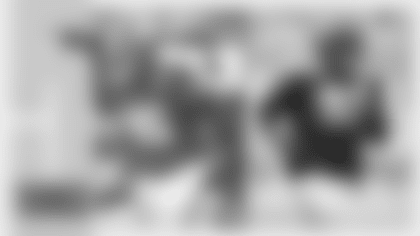Ron from Charlotte, NC
Bart Starr without a doubt is a great quarterback. After leading the Packers to four consecutive wins to close out 1959, how in the world did he end up as Lamar McHan's backup again in Games 2 through 5 in 1960? Bet you know the answer. Lombardi appears to have made very few mistakes. Was this one?
You're right, Starr turned out to be a great quarterback, whereas McHan never fulfilled his potential. The reason? McHan had a persecution complex. That's what several of his teammates have told me, and eventually they tired of it, as did Lombardi.
That was the reason McHan lost his job after the Pittsburgh game in 1960. Not only did Starr lead the Packers to victory after McHan was benched late in the third period, but in the locker room afterward McHan confronted his receivers and accused them of putting out more for Starr than they had for him. McHan never started again in Green Bay and was traded when the season ended.
That said, McHan was an outstanding athlete with a strong arm. He was a single-wing tailback at Arkansas and a three-time all-Southwest Conference choice. He not only led Arkansas in passing all three years, but also in rushing twice. He was ninth in Heisman Trophy voting in 1953 and the second pick in the 1954 NFL Draft.
Starr was in his fourth year before he won his first game as a starting quarterback. He didn't register his first win until the ninth game of Lombardi's first season. He also was limited athletically and didn't have a particularly strong arm. So when he went 8-for-22 for 68 yards in the 1960 opener and the Packers lost to the Bears, 17-14, Lombardi went back to McHan, who had won the first three games in 1959.
It took Lombardi some time to appreciate Starr's intangibles: His work ethic, leadership, stability, etc. I don't think that's unusual. I think just about every coach is going to give the more talented player first crack at a starting job. Obviously, Lombardi saw something in Starr from the beginning or he wouldn't have kept him. But I'll say this: I think Lisle Blackbourn, the Packers' coach from 1954-57, recognized Starr's latent virtues quicker than Lombardi did. Blackbourn just couldn't put all the other pieces together to maximize Starr's strengths.
Jon from Elletsville, IN
I'm a big fan of your work and do a little of my own Packers writing. I was wondering if you have any pointers about writing history. What is your research process like? How do you document things properly? Is there a right way to go about it?
I'm lucky. I had a grandmother and a high school history teacher who instilled in me a passion for history. I'm one of those boring folks who thinks a good movie is a documentary and only reads non-fiction. So like anything else, it all starts with having a passion for your work or hobby, and it sounds like you have that.
Research. Research. Research. That's the next part of the equation. When it comes to Packers history, I'd recommend relying almost solely on original sources for information about the first three, four decades. If you want to learn more about the Lambeau years, for example, go back and read the daily newspapers from 1919 to 1950. Before I took this gig, I read 40 years of the Green Bay Press-Gazette (1919-1962) and more than 50 years of the Milwaukee papers on microfilm, and made copies and saved every story that included something newsworthy. Now, the good news is you can find more and more newspapers online. While newspapers make mistakes and writers covering teams don't know or reveal everything, reading them would provide a good base. And the more you read, the more you'll be able to differentiate between the truth, usually what was written or said at the time, and myth, which usually results from someone claiming they remember something when they really don't.
Here's another benefit of reading old newspapers: You'll be able to get a feel for how things have changed over the years. One of the traps I have to constantly guard against is reading something and interpreting it in the context of today as opposed to when it happened.
Here's an example.
In 2005, I was on the Pro Football Hall of Fame selection committee when Benny Friedman, the most prolific passer of the pre-stats era, was elected. I thought Friedman was one of the best choices the Hall's senior committee made during my 13 years of voting. But from 1929-31, when Friedman played for the New York Giants and probably was at his best, the Packers won three straight NFL titles and were 4-1 against the Giants, who finished second by a half-game in both '29 and '30.
What was the difference between the teams?
When I went back and read the newspaper accounts, especially in the New York papers, I came away with the distinct impression it was because the Packers' Verne Lewellen had a much bigger impact as a punter and all-around back than Friedman had as a passer. Teams averaged less than 10 points a game back then and field position more than anything seemed to dictate offensive strategy.
Based on old newspaper play-by-plays, Eric Goska, author and Packers' stats guru, recently created a play-by-play of the 1929 late-season Packers-Giants game that settled that year's title.
According to Goska, Lewellen punted seven times and averaged 50.6 yards, including first-down punts of 75, 63, 43 and 65 yards. Lewellen punted for 354 yards and also accounted for 84 yards passing, rushing and receiving. Friedman accounted for 117 yards, second-most of any player in the game. He ran 18 times for 5 yards and passed 14 times for 112 yards from the tailback position in a single-wing.
David Neft, one of the foremost football historians of all-time, researched Lewellen's stats in much the same way as Goska and found that he had punted more than 100 times in each of three straight seasons, including 136 in 1928. Jacob Schum punted 56 times last season.
It's impossible to appreciate Lewellen's greatness without some comprehension of how different things were. And few, if any, recently published books will provide that.
Anyway, keep reading and enjoy what you do and you'll become more knowledgeable and a better writer of history. And thanks for being a loyal reader.
Jerry from Wilmington, NC
What would you say is the second-most iconic Packers game behind the "Ice Bowl"?
The game I just wrote about in the previous answer. It would be the Packers' 20-6 victory over the Giants on Nov. 24, 1929. It was the victory that propelled the Packers to their first NFL championship. It was a showdown of epic proportion: The Packers were 9-0 and the Giants, 8-0-1. And it was a dominant performance by the small-town Packers over a team from the largest city in the country when such topics created a much bigger buzz than they do today. By winning, the Packers were showered with more attention than they had ever received before.
In addition to the obvious, the David vs. Goliath angle that many New York writers latched onto, there also was another great storyline. The Packers used only 12 players. Ten played the entire 60 minutes and the 11th was forced out in the final minute with an injury.
Most important, I have my doubts the Packers would still be in existence today if they hadn't won. In 1929, there were eight NFL games that drew 20,000 or more people, including six Giants game at the Polo Grounds. The Packers-Giants game drew 25,000, tied for fourth largest in the NFL.
It also was the largest crowd the Packers had played before in their 11 years of existence and by 10,000-some people. As one would expect, the Giants' two biggest crowds that season were for early-season games against crosstown Staten Island and Frankford, a neighborhood in Philadelphia, New York's civic rival. Remember, everything was more provincial back then. Geographic rivalries were what brought out the crowds.
But as a result of the Packers winning in '29, Packers-Giants games in New York supplanted all others as the hottest ticket in pro football. The next two years, their matchup drew 37,000 and 35,000, respectively, the two biggest NFL crowds in each of those two years. That was the key to the Packers' survival during the Great Depression and their more than 17 months in receivership. They became the biggest draw in the league. That's why other owners, most notably George Halas and Tim Mara of the Giants, did everything possible to ensure their survival.
Scott from Greensburg, IN
I liked your list of best Packers No. 1 draft picks, but I would ask you to consider another. In my opinion, Packers fans forget how incredibly good Sterling Sharpe really was. It's strange how players who suffer career-ending injuries are treated by the press and by historians. Some become legends like Bo Jackson. Some get ushered right into the Hall of Fame like Gale Sayers. I feel it is a great oversight Sharpe is not enshrined in Canton.
Oh boy! Where do I start? First, your email was well thought out and it sounds like you're at least a second-generation Packers fan who might have caught the tail end of the Lombardi era sitting at your dad's knee, then stuck with the team through the ghastly 1970s and '80s. Obviously, you also have a serious interest in Packers history. So I'm going to answer your question as respectfully as I can, but also be forthright about where I stand.
As you may know, I was part of the Hall of Fame selection process for 13 years so I get what a subjective exercise it is and how frustrating it can be for candidates, voters and fans alike. One other point: Jordy Nelson's place in Packers history is still to be determined. But from what I've observed and heard from coaches and scouts, I agree with you that Sharpe is clearly the best of the Packers receivers over the Majkowski-Favre-Rodgers years and the only one who deserves consideration for the Pro Football Hall of Fame.
That said, if Sharpe had been a finalist during my time on the selection committee, from 2001-14, I probably wouldn't have voted for him. I also didn't vote for Bob Hayes, Art Monk, Cris Carter, or Andre Reed, and I waffled on Tim Brown. In my mind, Otis Taylor of the Kansas City Chiefs was better than all of them and that was my standard. If Taylor wasn't good enough to be in the Hall of Fame, I wasn't going to vote for anybody that I believed was a decidedly lesser receiver.
My opinion about Sharpe has nothing to do with how he treated the press. When I started covering the Packers on a daily basis in 1974, many times when I'd walk in the locker room, Gale Gillingham would snarl and call me a "poison pen blankety blank." No big deal. He was putting on a show for the other offensive linemen and I had a job to do. I don't believe you can cover a team well and allow personal affronts to affect you. Had Gillingham been a candidate when I was on the committee, I would have voted for him.
Where you and I probably differ is that I'm not a big stats guy, especially with all these modern-day receivers. For a receiver to be a Hall of Famer in my eyes, his talent has to jump off the field at me. Randy Moss, Calvin Johnson of more recent vintage. Michael Irvin was another because of all his big plays. That's also why I'd vote for Terrell Owens if I was still on the committee. On the other hand, Canton could open a whole new wing for the Wes Welkers and Julian Edelmans of the world if voters continue to relax the standards.
See why I started this with an "Oh boy"? Let the invective start piling up in the comments section.
Anyway, that's why Sharpe didn't meet my eyeball test the way James Lofton did, for example. I think there was a clear difference between the two. Granted, Sharpe was different from most wide receivers and, thus, that test might be somewhat unfair to him. At the same time, you referred several times to his stats. I thought he had three great seasons, but was a disappointment as a rookie and I remember how scouts were talking in '94 that he had slowed down, probably from the turf toe issue.
Let's face it, in Sharpe's best seasons, the other receiver was Perry Kemp, Sanjay Beach and Mark Clayton. In both Lindy Infante's and Mike Holmgren's pass-oriented offenses, who else was going to catch passes? Who else was there to even throw to? Ed West, "The Toolbox" – and I write that with all due respect – was the tight end for most of the time.
I remember the argument for Monk was that he was the NFL's all-time leading receiver at one point. So was Billy Howton, the Packers' star of the 1950s and he was never even a finalist. He broke Don Hutson's record for catches and yardage. Why isn't he in the Hall of Fame? Raymond Berry, whose opinion about wide receivers might be the most credible of anyone in football, thinks Howton deserves consideration.**I put Sharpe ahead of Howton on my list of all-time Packers receivers, but only by the slimmest of margins**.
You mentioned Sayers. He was the most exciting runner I've seen in 60 years of watching the NFL. I just read some comments Ray Nitschke made about him. I believe if you had polled the Packers defenders in the 1960s, they would have said Sayers struck more fear in them than Jim Brown. Of the 32 modern-era halfbacks-fullbacks in Canton, Sayers would be one of six that I'd consider for a Mount Rushmore of greatest runners ever. Despite a short career, Dwight Stephenson fell in that category among centers. I don't see Sharpe being in the same class among receivers.
Again, my standard for players with short careers was Cecil Isbell. If Isbell wasn't in the Hall of Fame, I wasn't going to vote for any player who didn't accomplish what he did over a minimum of five seasons. That's why I never would have voted for Terrell Davis. He had four very good to outstanding years, but he was no Sayers. Not even close.
Isbell played five years for the Packers (1938-42) and retired to go into coaching. Sammy Baugh entered the NFL a year before Isbell. But in the five years they were in the league together, Isbell threw for almost 500 more yards, received as much if not more all-pro recognition and became the first passer in NFL history to surpass 2,000 yards while Baugh's highest total was 1,524. Eight games into Isbell's rookie year when he was sharing passing duties with future Pro Football Hall of Famer Arnie Herber, George Halas said Isbell was the better of the two. In the NFL's Top 100 voting in 2010, Baugh was rated the 14th greatest player ever. So for five years, Isbell couldn't have been in better company. Yet Davis, maybe a four-year wonder, gets in the Hall of Fame ahead of him.















